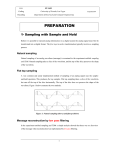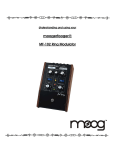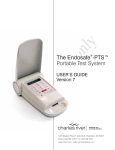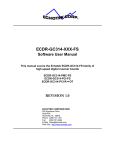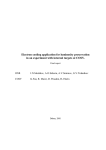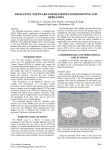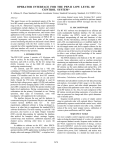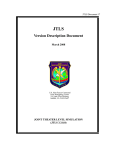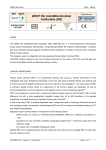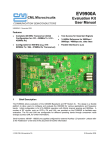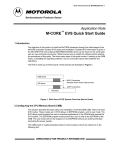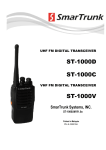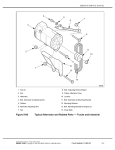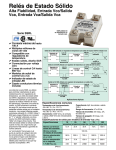Download tupsm029
Transcript
TUPSM029 Proceedings of BIW10, Santa Fe, New Mexico, US DESIGN AND PERFORMANCE OF SSRL BEAM POSITION ELECTRONICS* J. Sebek#, D. Martin, T. Straumann, J. Wachter, SSRL/SLAC, Menlo Park, CA 94025, U.S.A. Abstract SSRL designed and built beam position electronics for its SPEAR storage ring. We designed the electronics, using digital receiver technology, for highly accurate turn by turn measurements of both the position and arrival time of the beam, allowing us to use this system to measure the betatron and synchrotron tunes of the beam. The dynamic range of the system allows us to measure the properties of the beam at currents ranging from those of single bunch injection to those of the full SPEAR stored beam. This paper discusses the architecture of the electronics, presents their performance specifications, and shows a range of applications of this system for accelerator physics experiments. SPEAR PARAMETERS SPEAR is a 3 GeV electron storage ring used for synchrotron radiation. The operational beam current is now 200 mA; the ring will run at 500 mA after all of the beamline optics have been commissioned. The beam emittance is 10 nm, the vertical beam size is 30 μm, and the bunch length is 5 mm. The radio frequency (RF) of the SPEAR klystron is 476.316 MHz and the ring circumference is 234.3 meters; the harmonic number of SPEAR is 372 and its revolution frequency is 1.28 MHz. ORBIT FEEDBACK BPM ELECTRONICS We use a modified version of the Bergoz MX-BPM processor [1] to measure the beam position monitor (BPM) signals for our orbit feedback system. We use 60 BPM processors to monitor the beam position and 60 steering magnets to correct the orbit. Our feedback algorithm updates at a rate of approximately 4 kHz. Our target orbit stability is 3 μm in a 1 Hz bandwidth, 10% of the nominal vertical beam size. Our orbit feedback system achieves a stability of a few hundred nm, an order of magnitude better than our requirements. SINGLE TURN BPM ELECTRONICS We also wanted a high performance BPM processor that was optimized for machine physics applications. Therefore it needed to produce highly accurate turn by turn data of the beam from which we could extract the dynamics of the machine. We have 18 of these electronics, one for each sector of the ring. Machine physics use requires the electronics to work over a large dynamic range, from injected beam to stored beam at full current and it needs to work for all potential ___________________________________________ *Work supported by the U.S. Department of Energy under contract number DE-AC02-76SF00515 # [email protected] Instrumentation 182 fill patterns, ranging from the standard fill pattern, when almost all buckets are full, to single bunch studies. In particular we need to be able to use this processor to measure the betatron and synchrotron oscillations of the beam, both when we are driving the beam and the oscillations are strong, as well as when the beam is quiet. BEAM SPECTRUM Ideal Bunch In order to motivate our system architecture, we first briefly review the properties of a relativistic beam in a storage ring. The ideal beam circles the ring at the revolution period T. If the bunch were ultra-relativistic, a point particle, and the BPM button had infinite bandwidth, the signal would be a series of delta functions ( )= ( − ), where Q is the bunch charge. Because of its periodic nature the current can be expressed in a Fourier series ( )= , where = 2 / , showing that the spectrum consists only of the harmonics of the revolution frequency. Even though there are an infinite number of harmonics, they all carry the same information about the bunch. Finite size of the bunch and finite bandwidth of the pickup give Q a dependence on the frequency ω. The ring may have up to h bunches, where h is the harmonic number of the ring. The beam spectrum is still composed of the harmonics of ω0, but now the amplitude of the various harmonics depends on the fill pattern of the ring. For example, if h is even, and every other bunch is equally filled, only the coefficients of the even harmonics are non-zero; one cannot distinguish between this situation and one in which the ring is half as large (with twice the revolution frequency) but in which every bunch is filled. But even though there are an infinite number of harmonics, the number of independent terms is finite. In fact, since there are h bunches, there are only h independent coefficients Qk. The coefficient corresponding to the klystron RF frequency ωRF, and all of its multiples, is the same as the DC coefficient. In order to obtain a signal independent of bunch pattern, one needs to process the signal at a harmonic of ωRF. Dynamic Bunch We can see what happens to a dynamic bunch by making a slowly varying approximation to the Fourier expansion. A beam executing transverse motion about its nominal trajectory will have a time-varying amplitude; a Proceedings of BIW10, Santa Fe, New Mexico, US beam executing longitudinal motion will have a timevarying phase. Therefore our Fourier expansion for a dynamic beam is ( )= ( ) ( ) where ( )= ( + ( )) ( )is and the deviation in arrival time from the nominal particle. Note that ( ) ≪ . We can therefore find a mode of the beam motion by measuring the slowly varying amplitude and phase of the beam. Betatron oscillations are characterized as sinusoidal variations of ( ), corresponding to amplitude modulation, and synchrotron oscillations are sinusoidal variations of ( ), corresponding to phase modulation. A beam with n bunches has n degrees of freedom. Therefore, in order to measure all possible motions of the beam, one needs to measure either n bunches in the time domain or n harmonics (modes) in the frequency domain. These are the methods used in feedback systems. However, one can investigate the dynamics of a system by driving one mode, the common mode ( = 0) in which all bunches have the same motion, and observing the beam response. The harmonics of ωRF correspond to this common mode. SIGNAL PROCESSING We now know that we can obtain the information that we want by extracting the information at ωRF and measuring its slowly varying amplitude and phase. We will digitize our data, resulting in a stream of digital data to process. We now describe the signal processing algorithm that we use on this data to achieve our goal. Since we deal with a finite number of samples, our processing involves a discrete filtering process. With the appropriate choice of frequencies, and the appropriate choice of our hardware architecture, we will see that this filtering process is accomplished with a discrete Fourier transform (DFT). In general, it is very difficult to obtain the exact information about one frequency from a DFT. This is because a DFT has only finite resolution. It samples a finite section of a waveform at N discrete, usually equally spaced, times TS. The DFT assumes that this section of length NTS repeats periodically. Therefore, since even a pure sinusoid, in general, does not have an integral number of periods during these N samples, the DFT does not interpret this signal as a sinusoid, but rather as a concatenation of identical sinusoidal segments. If the sinusoid is not continuous in amplitude and slope, a cusp arises in this infinite waveform. The DFT interprets this cusp as higher frequencies that alias into a measured frequency. Only for a select set of problems can one construct the system to avoid these problems and exactly measure the frequency of interest. The beam signal from a storage ring belongs to this set. As seen above, all of the frequencies of interest are multiples of the revolution Instrumentation TUPSM029 harmonic ω0. If we sample for a period of time that is = , then all of the exactly one revolution period, revolution harmonics have an integral number of wavelengths during this period. The equally spaced revolution harmonics are the orthogonal basis vectors of the DFT. In the frequency domain, the response of the DFT is a series of sinc functions centered on the revolution harmonics. The sinc amplitudes are unity at their central harmonics and zero at the other harmonics. The DFT separates out the different revolution harmonics to the arithmetic precision of the digital processor. The DFT produces a complex amplitude ( ) ( ) for each harmonic during each revolution period; the real part is the in-phase (I) signal component and the imaginary part is the quadrature (Q) component. On each revolution we use I and Q to calculate the magnitude | ( )| = + and the phase kω τ(t) = tan of the revolution harmonic. HARDWARE CONSIDERATIONS Timing In order to implement our system, we needed to assemble a synchronous timing system that could support the required timing infrastructure. Our system clock, fRF, comes from a PTS-500 programmable frequency source [2]. In addition to its low noise specifications, the PTS500 is phase continuous when its frequency is changed. We need this property since fRF is part of our orbit feedback system, we change it to correct for the diurnal dispersion component of our orbit. We then specified a frequency distribution chassis [3] that generates from fRF all of our synchronous system clocks. For the purposes of this article, the two frequencies of interest are a local oscillator (LO) used in the down-converter of the BPM and a digitizer clock. The LO frequency, fLO, is exactly 359 times the revolution frequency f0, so that our intermediate frequency (IF) will be exactly 13f0. The system clock is 50f0. We use 50 samples per revolution to measure exactly 13 periods of fIF. (We also note that the sampling of our orbit feedback BPM electronics is also synchronous with fRF. We sample each of the multiplexed BPM buttons for exactly 80T0; a complete module of four buttons is sampled every 320T0 which is almost exactly 250 µs. This is also the rate at which our orbit feedback system calculates corrections and at which the steering magnets update their corrections.) BPM Electronics Design We designed, specified, and procured our hardware for this system before the December, 2003 commissioning of 183 Proceedings of BIW10, Santa Fe, New Mexico, US SPEAR3. At that time, 14 bit, 65 MSPS digitizers were at the leading edge of commercial digitizers. The easiest way to implement our DFT algorithm was to use a commercially available digital receiver chip (subsequent improvements in technology may now make the preferred filter element an FPGA). We specified and purchased a digital receiver (DR) board [4] and designed our own RFIF down converter. The DR board supports eight channels of input, enough for two BPM modules. Two programmable DR chips are devoted to each channel. There is also on-board memory that holds 128k samples for each channel; this corresponds to approximately 100 ms of data capture, much longer than the time of any beam phenomenon. RF-IF Converter Although the digitizers used in our DR board are capable of direct RF sampling, there are many technical advantages to first down-converting the RF signal to an IF. First, although the performance of the digitizer is still good at fRF, the performance is even better at lower ≅ 16.645 MHz). Second, since there frequencies (our are technical limitations on the quality factors of inexpensive band-pass filters, it is easier to construct analog band-pass filters of the appropriate width at fIF than at fRF. Finally, the accuracy of the phase measurement depends on the relative jitter of each clock sample as measured in radians of the frequency to be measured. By decreasing the frequency we process by a factor of almost 30, we improve the phase accuracy of our measurements by more than an order of magnitude. Analog Signal Processing Although we finally digitally process our signal, we still need an analog signal processing stage to optimize the system performance. We use a dielectric resonator band-pass filter at fRF [5] to limit the peak voltage into our electronics. Such commercial filters can achieve about a 1% bandwidth, so the length of the impulse response is shorter than desired. These filters are periodic structures, so although they reject very well frequencies near their center frequency fC, they also pass higher harmonics of fC. To reject these frequencies, we added a coaxial 600 MHz low pass filter upstream of the electronics. We performed our desired filtering at the IF, where we built a Gaussian response filter with a bandwidth of 2 MHz. The response and bandwidth were chosen so that an impulse response of a single bunch would provide signal over the entire 50 samples of a single period T0 yet decay without ringing before the next period. Lengthening the impulse response also reduces the peak amplitude seen by the digitizer. Instrumentation 184 4 sampled data x 10 2 1 amplitude TUPSM029 0 -1 -2 0 20 40 60 sample 80 100 Figure 1: Two turns of IF samples We used several stages of amplification. The gain block in the RF stage was chosen for its low noise figure; the one in the IF stage was chosen for its low distortion. The RF gain block is used to amplify the signal for low beam current applications. Both the RF gain block and the IF filter are switchable so that the electronics can be optimized for different applications. Calibration We chose to calibrate our system using a constant calibration tone. We have combiners [6] located inside of our ring, near the BPM modules, and there combine the calibration tone with the signals from the beam. The continuous signal allows us to avoid switches, so that we do not have to skip data or compensate for switching transients. Our calibration frequency is chosen to be 1/2f0 below fRF, well within the bandwidth of our analog stages. For technical reasons, it is generated by a second frequency synthesizer that is locked to the master synthesizer. (For stability reasons, the tunes in a light source are always far away from the half-integer.) In this mode, we have both DR chips run on each channel and instead of producing a measurement each revolution, we output data every second turn. This allows the two signals to be orthogonal to each other in the two DRs. The calibration is only used during normal operation of the BPM electronics with stored beam. It is turned off during machine physics studies. RESULTS Accuracy We first measure the accuracy of the BPM electronics by examining the data for nominal user beam with a standard fill. Figure 1 shows 100 samples, two complete turns of data; the periodicity of the system is evident. Proceedings of BIW10, Santa Fe, New Mexico, US button 1 mean = 6581.7929 σ = 2.2804 6590 counts 6585 6580 TUPSM029 Spectral Purity The spectral resolution of the horizontal beam position measurement is displayed by the Fourier transform of the turn by turn data displayed in Figure 5. The noise floor of the measurement is approximately 115 dB below the carrier, with spurs about 20 dB above this floor. All of the tunes for a normal, quiet beam are clearly visible. Again we see that the synchrotron tune is visible in the horizontal beam spectrum; this is due to the BPM location in a dispersive section of the ring. 6575 relative x position mean = -0.11212 σ = 0.00023 0 20 40 60 time (ms) 80 -0.1115 100 The data in Figure 2 is taken on a vacuum chamber with a 17 mm half height. The standard deviation measured for this 100 ms of data gives an accuracy of about 7 µm per turn (781 ns). Δ/Σ Figure 2: Turn by turn data for one button. -0.112 -0.1125 button 1 mean = 6581.7929 σ = 2.2804 6586 0 0.5 time (ms) 6584 Figure 4: First 1 ms of horizontal position. counts 6582 phase stddev = 4.09 milliradians = 1.4 ps 6580 -0.51 6576 0 0.2 0.4 0.6 time (ms) 0.8 1 Figure 3: First 1 ms of turn by turn data. However the standard deviation includes contributions from beam motion, including synchrotron oscillations (in dispersive regions) driven by transients in the klystron high voltage power supply. If one instead measures σ from the noise on the peaks of the synchrotron oscillations in Figure 3, the resolution of each button, before the position is calculated, is seen to be approximately 1.4 µm per turn on a 34 mm high chamber. We calculate the beam position using the standard difference over sum calculation using the four buttons. Figure 4, which shows the first ms of data shows that this calculation improves the sensitivity of the measurement. The phase measurement is also very accurate. Figure 5 shows that the standard deviation of the phase over 100 ms corresponds to 1.4 ps at ωRF. However, estimating the σ from the noise at the top of the oscillations shows that our accuracy is better than 100 fs. Note that, as expected, the energy oscillations in Figure 4 are in quadrature with the phase oscillations in Figure 5. phase (radians) 6578 6574 1 -0.52 -0.53 -0.54 0 0.2 0.4 0.6 time (ms) 0.8 1 Figure 5: First 1 ms of bunch phase. The horizontal tune line, only slightly visible in the dense spectrum in Figure 6, is about 25dB above the noise floor of the electronics, as seen in Figure 7. The vertical and synchrotron tune lines are also very visible from the spectra. Low Current Injection Studies Finally we look at data from low current injection studies. A single bunch of current is injected into SPEAR every 100 ms. In order to optimize injection, one needs to determine that the phase delay between the injector and SPEAR is correct and that the energy of the injected beam matches the SPEAR energy [7]. Instrumentation 185 TUPSM029 Proceedings of BIW10, Santa Fe, New Mexico, US x fft carrier suppressed -60 -80 0.2 Δ/Σ -100 dBC relative x position 0.4 -120 0 -140 -0.2 -160 -180 0 200 400 frequency (kHz) -0.4 600 νx (carrier suppressed) Figure 8a: beam. -90 phase 4 phase (radians) -110 dBC 100 Horizontal position of mis-timed injected 4.5 -100 -120 -130 -140 -150 3.5 3 2.5 134 136 138 frequency (kHz) 140 Figure 7: Horizontal tune. The injected current is only 50 µA per pulse, four orders of magnitude lower than the maximum current in the ring. One cannot measure this low current in the presence of a stored beam, but the injected beam can be stored and then kicked out before the next injection cycle. At these currents, the digitizer is at its bit resolution, but the signal is still well above the noise floor. By averaging multiple injections, in this case sixteen cycles were averaged, the effective resolution of the digitizer increases and the desired signals can be accurately measured. Figures 8a and 8b show the horizontal position and phase, respectively of a mis-timed injected beam. The position signal executes expected betatron oscillations due to the injection kickers. Both signals execute synchrotron oscillations. Since the position signal is sinelike and the phase signal is cosine-like, the injected beam has the proper energy, but the incorrect phase. Proper tuning of the injector phase reduces the measured phase oscillation to ±0.1 radians. Instrumentation 186 50 time (μs) Figure 6: Spectrum of horizontal position. -160 0 2 0 50 100 time (μs) Figure 8b: Phase of mis-timed injected beam. REFERENCES [1] MX-BPM User’s Manual Spear-3 options, Bergoz Instrumentation, Saint Genis Pouilly, France; http://www.bergoz.com. [2] Programmed Test Sources, Inc., Littleton, MA; http://www.programmedtest.com. [3] Wenzel Associates, Inc., Austin, TX; http://www.wenzel.com. [4] Echotek Division of Mercury Computer Systems, Huntsville, AL; http://www.mc.com. [5] Integrated Microwave, San Diego, CA; http://www.imcsd.com [6] Mac Technology, Inc., Klamath Falls, OR; http://www.mactechnology.com [7] X. Huang, et al., “Optimization of the Booster to Spear Transport Line for Top-Off Injection,” PAC’09, Vancouver, May 2009, TU6RFP043.





